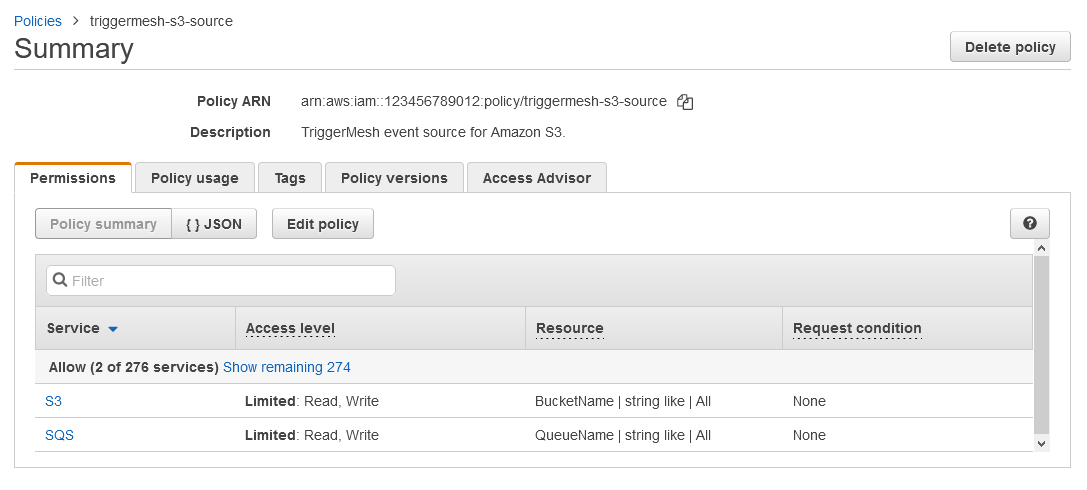Amazon S3 source
This event source subscribes to event notifications from an Amazon S3 bucket. Events are published by S3 to an Amazon SQS queue in order to be consumable by the event source.
With tmctl:
tmctl create source awss3 --arn <arn> --eventTypes <eventTypes> --auth.credentials.accessKeyID <keyID> --auth.credentials.secretAccessKey <key>
On Kubernetes:
apiVersion: sources.triggermesh.io/v1alpha1
kind: AWSS3Source
metadata:
name: sample
spec:
arn: arn:aws:s3:::triggermeshtest
eventTypes:
- s3:ObjectCreated:*
- s3:ObjectRemoved:*
auth:
credentials:
accessKeyID:
valueFromSecret:
name: awscreds
key: aws_access_key_id
secretAccessKey:
valueFromSecret:
name: awscreds
key: aws_secret_access_key
sink:
ref:
apiVersion: eventing.knative.dev/v1
kind: Broker
name: default
Parameters:
- Bucket ARN: ARN of the S3 bucket, as described in the previous sections.
- Queue ARN: (optional) ARN of the SQS queue which acts as event destination, in case you prefer to manage this queue yourself as described in the previous sections.
- Event types: List of event types to subscribe to.
Events produced have the following attributes:
- types
com.amazon.s3.objectcreatedcom.amazon.s3.objectremovedcom.amazon.s3.objectrestorecom.amazon.s3.reducedredundancylostobjectcom.amazon.s3.replicationcom.amazon.s3.testevent
- Schema of the
dataattribute: com.amazon.s3.event.json
See the Kubernetes object reference for more details.
Prerequisite(s)
- S3 Bucket
- Amazon Resource Name (ARN)
- API Credentials
- SQS Queue (optional)
S3 Bucket
If you didn't already do so, create a S3 bucket by following the instructions at Create your first S3 bucket.
Amazon Resource Name (ARN)
A fully qualified ARN is required to uniquely identify the Amazon S3 bucket.
Note
Although not technically required by S3, the ARN provided to this event source may include an AWS region and account ID, in addition to the bucket name. When this information is provided, it is used to set an accurate identity-based access policy between the S3 bucket and the reconciled SQS queue, unless a user-managed queue is provided as described in the SQS Queue section of this document.
The format of such ARN is:
This information is purely optional and will be determined automatically if not provided.

API Credentials
The TriggerMesh event source for Amazon S3 authenticates calls to the AWS API using AWS Access Keys. The page Understanding and getting your AWS credentials contains instructions to create access keys when signed-in either as the root user or as an IAM user. Take note of the Access Key ID and Secret Access Key, they will be used to create an instance of the event source.
It is considered a good practice to create dedicated users with restricted privileges in order to programmatically access AWS services. Permissions can be added or revoked granularly for a given IAM user by attaching IAM Policies to it.
As an example, the following policy contains only the permissions required by the Amazon S3 event source to operate:
{
"Version": "2012-10-17",
"Statement": [
{
"Sid": "S3SourceSetBucketConfig",
"Effect": "Allow",
"Action": [
"s3:GetBucketNotification",
"s3:PutBucketNotification"
],
"Resource": "arn:aws:s3:::*"
},
{
"Sid": "S3SourceConsumeMessages",
"Effect": "Allow",
"Action": [
"sqs:GetQueueUrl",
"sqs:ReceiveMessage",
"sqs:DeleteMessage"
],
"Resource": "arn:aws:sqs:*:*:*"
}
]
}
Additionally, the following permissions are also required if you opt for letting the event source manage the SQS queue for you (see next section for more information):
{
"Version": "2012-10-17",
"Statement": [
{
"Sid": "S3SourceGetBucketLocation",
"Effect": "Allow",
"Action": [
"s3:GetBucketLocation"
],
"Resource": "arn:aws:s3:::*"
},
{
"Sid": "S3SourceManageQueue",
"Effect": "Allow",
"Action": [
"sqs:CreateQueue",
"sqs:DeleteQueue",
"sqs:GetQueueAttributes",
"sqs:SetQueueAttributes",
"sqs:GetQueueUrl",
"sqs:ListQueueTags",
"sqs:TagQueue"
],
"Resource": "arn:aws:sqs:*:*:*"
}
]
}

SQS Queue (optional)
The TriggerMesh event source for Amazon S3 configures the S3 bucket to send event notifications to an Amazon SQS queue.
By default, the source creates and manages a SQS queue for that purpose on behalf of the user. An identity-based policy is set on that SQS queue to only accept messages originating from the configured S3 bucket.
Alternatively, in case you prefer not to delegate this responsibility to the event source, it is possible to provide your own SQS queue as an event destination. In this scenario, it is your own responsibility to configure the queue according to Amazon's documentation: Configuring a bucket for notifications.